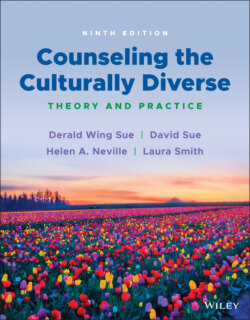Читать книгу Counseling the Culturally Diverse - Laura Smith L. - Страница 105
THE EVOLUTION OF THE “ISMS”: MICROAGGRESSIONS
ОглавлениеMicroaggressions are “brief and commonplace daily verbal or behavioral indignities, whether intentional or unintentional, that communicate hostile, derogatory, or negative racial slights and insults that potentially have a harmful or unpleasant psychological impact on the target person or group” (Sue, Bucceri, Lin, Nadal, & Torino, 2007). They can also be delivered environmentally, as in the case of Melanie, through the physical surroundings of target groups, where they are made to feel unwelcome, isolated, unsafe, and alienated.
The term “macroaggression” (Huber & Solorzano, 2015; Sue, Calle, Mendez, Alsaidi, & Glaeser, 2021) refers to systemic and institutional forms of discrimination that impact an entire class of individuals. They are said to reside in the policies, programs, practices, and structures of institutions that disadvantage or oppress socially devalued groups, while benefiting others. Some of them are codified into law such as the former travel ban on Muslim‐majority countries, the former Family Separation Policy, and new voter suppression laws. As explained by Sue et al. (2021), racial macroaggressions represent an overarching umbrella that validates, supports, and enforces the manifestation of individual acts of racial microaggressions.
Based on the literature on subtle forms of oppression, one might conclude the following about microaggressions: they (a) tend to be subtle, unintentional, and indirect; (b) often occur in situations where there are alternative explanations; (c) represent unconscious and ingrained biased beliefs and attitudes; and (d) are more likely to occur when people pretend not to notice differences, thereby denying that race, sex, sexual orientation, religion, or ability had anything to do with their actions (Sue, Capodilupo, et al., 2007). Three types of microaggression have been identified: microassault, microinsult, and microinvalidation.
